#History of the Corinth from its foundations
Text
History of Corinthe from its Foundation, part 1
THE Parisians who nowadays on entering on the Rue Rambuteau at the end near the Halles, notice on their right, opposite the Rue Mondétour, a basket-maker's shop having for its sign a basket in the form of Napoleon the Great with this inscription:
NAPOLEON IS MADE
WHOLLY OF WILLOW,
have no suspicion of the terrible scenes which this very spot witnessed hardly thirty years ago.

It was there that lay the Rue de la Chanvrerie, which ancient deeds spell Chanverrerie, and the celebrated public-house called Corinthe.
The reader will remember all that has been said about the barricade effected at this point, and eclipsed, by the way, by the barricade Saint-Merry. It was on this famous barricade of the Rue de la Chanvrerie, now fallen into profound obscurity, that we are about to shed a little light.
May we be permitted to recur, for the sake of clearness in the recital, to the simple means which we have already employed in the case of Waterloo. Persons who wish to picture to themselves in a tolerably exact manner the constitution of the houses which stood at that epoch near the Pointe Saint-Eustache, at the northeast angle of the Halles of Paris, where to-day lies the embouchure of the Rue Rambuteau, have only to imagine an N touching the Rue Saint-Denis with its summit and the Halles with its base, and whose two vertical bars should form the Rue de la Grande-Truanderie, and the Rue de la Chanvrerie, and whose transverse bar should be formed by the Rue de la Petite-Truanderie. The old Rue Mondétour cut the three strokes of the N at the most crooked angles. So that the labyrinthine confusion of these four streets sufficed to form, on a space three fathoms square, between the Halles and the Rue Saint-Denis on the one hand, and between the Rue du Cygne and the Rue des Prêcheurs on the other, seven islands of houses, oddly cut up, of varying sizes, placed crosswise and hap-hazard, and barely separated, like the blocks of stone in a dock, by narrow crannies.

We say narrow crannies, and we can give no more just idea of those dark, contracted, many-angled alleys, lined with eight-story buildings.

These buildings were so decrepit that, in the Rue de la Chanvrerie and the Rue de la Petite-Truanderie, the fronts were shored up with beams running from one house to another.

The street was narrow and the gutter broad, the pedestrian there walked on a pavement that was always wet, skirting little stalls resembling cellars, big posts encircled with iron hoops, excessive heaps of refuse, and gates armed with enormous, century-old gratings. The Rue Rambuteau has devastated all that.
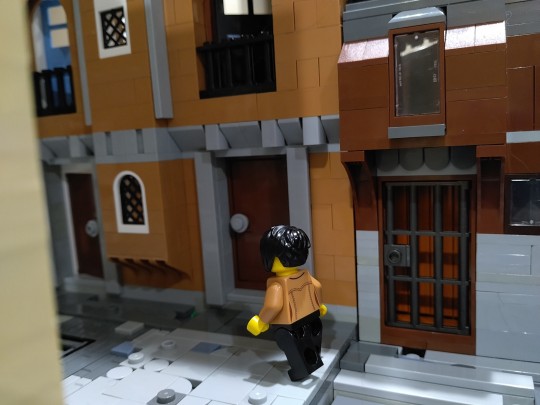
[...] The passer-by who got entangled from the Rue Saint-Denis in the Rue de la Chanvrerie beheld it gradually close in before him as though he had entered an elongated funnel.

At the end of this street, which was very short, he found further passage barred in the direction of the Halles by a tall row of houses, and he would have thought himself in a blind alley, had he not perceived on the right and left two dark cuts through which he could make his escape. This was the Rue Mondétour, which on one side ran into the Rue de Prêcheurs, and on the other into the Rue du Cygne and the Petite-Truanderie. At the bottom of this sort of cul-de-sac, at the angle of the cutting on the right, there was to be seen a house which was not so tall as the rest, and which formed a sort of cape in the street. It is in this house, of two stories only, that an illustrious wine-shop had been merrily installed three hundred years before.

In the time of Mathurin Regnier, this cabaret was called the Pot-aux-Roses, and as the rebus was then in fashion, it had for its sign-board, a post (poteau) painted rose-color. In the last century, the worthy Natoire, one of the fantastic masters nowadays despised by the stiff school, having got drunk many times in this wine-shop at the very table where Regnier had drunk his fill, had painted, by way of gratitude, a bunch of Corinth grapes on the pink post. The keeper of the cabaret, in his joy, had changed his device and had caused to be placed in gilt letters beneath the bunch these words: "At the Bunch of Corinth Grapes (Au Raisin de Corinthe"). Hence the name of Corinthe. Nothing is more natural to drunken men than ellipses. The ellipsis is the zig-zag of the phrase. Corinthe gradually dethroned the Pot-aux-Roses. The last proprietor of the dynasty, Father Hucheloup, no longer acquainted even with the tradition, had the post painted blue.

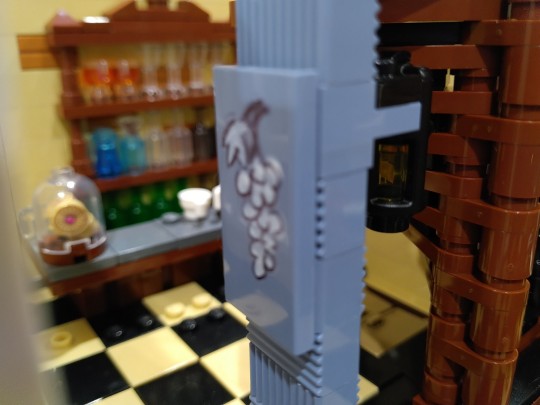
44 notes
·
View notes
Text
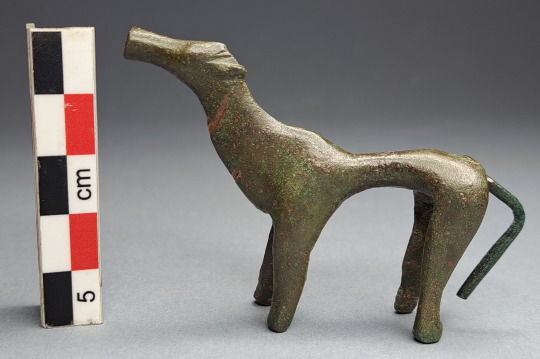
2,600-Year-Old Artifacts Found at Ancient Greek Cult Center
Around 2,600 years ago, the Greek city of Helike was destroyed when a violent earthquake and tsunami struck the region, leaving the city buried.
Archaeologists and researchers have pursued explorations of the city’s remains for decades, and recent excavations have begun uncovering more about Helike’s cult center, according to a news release from Greece’s Ministry of Culture.
Previous excavations of the site revealed an arched temple dating between 710 and 700 B.C., with a brick altar dating to 760 to 750 B.C., officials said. The latest round of excavations, from May 2 until June 23, focused on the remains of two more buildings and more religious remains.
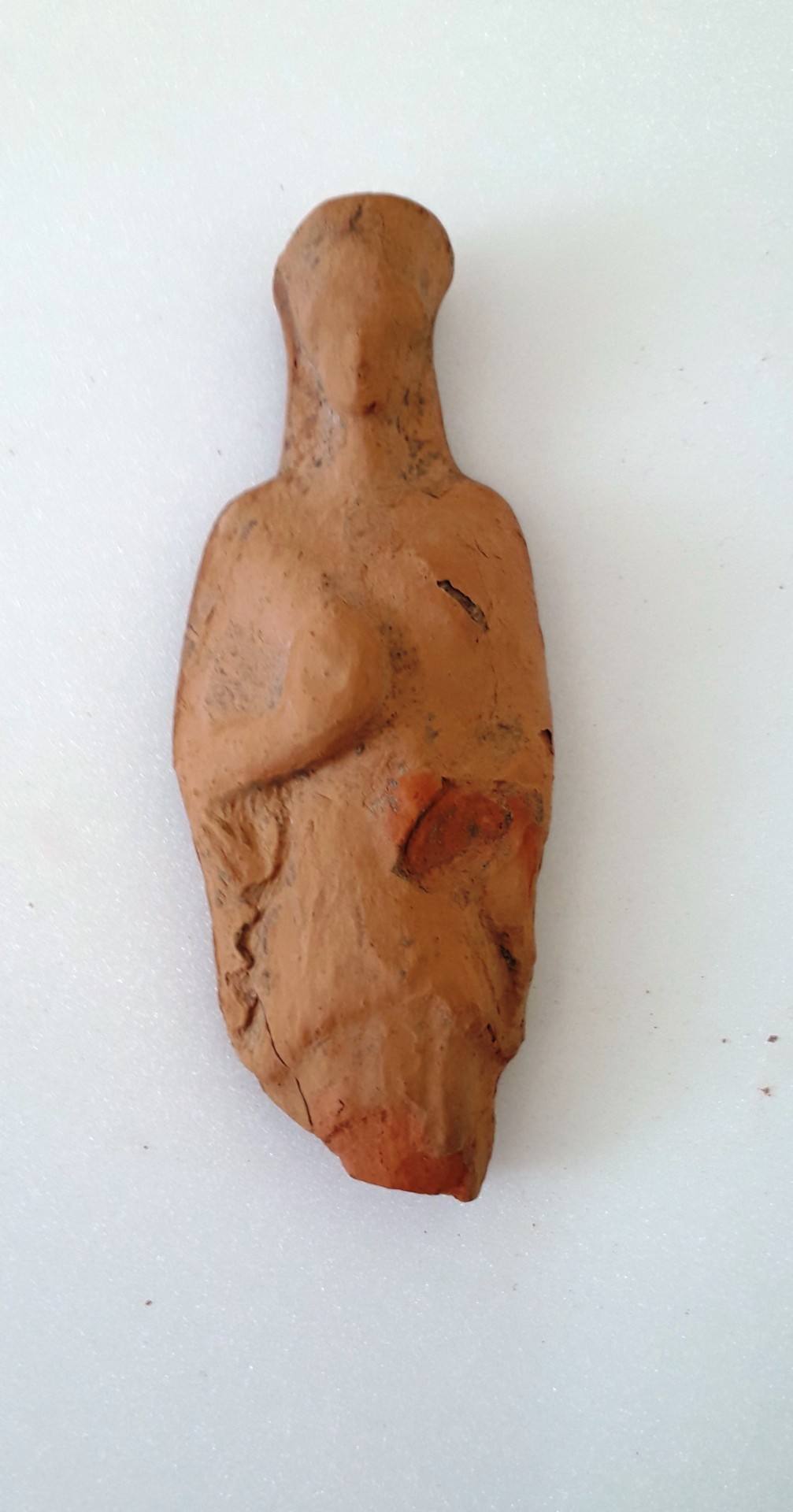
Experts said the first building they explored dates to the eighth century B.C. It had pressed soil floors and an approximately 60- to 65-foot-long wall, and it appears to have been used in three different phases.
The remains of the second building included a temple-shaped stone foundation dating to the seventh7 or sixth century B.C., officials said.
It was filled with light pottery dating to the Archaic era — which lasted from around 800 B.C. until 479 B.C., according to the World History Encyclopedia — as well as clay figurines and a bronze snake head, archaeologists said. A clay wing that belonged to a depiction of a mythological figure was also found during the excavations.
East of the two buildings, researchers unearthed a number of artifacts dating to the eighth and ninth centuries B.C. Experts said these discoveries confirm the use of the space for religious purposes as early as 850 B.C.
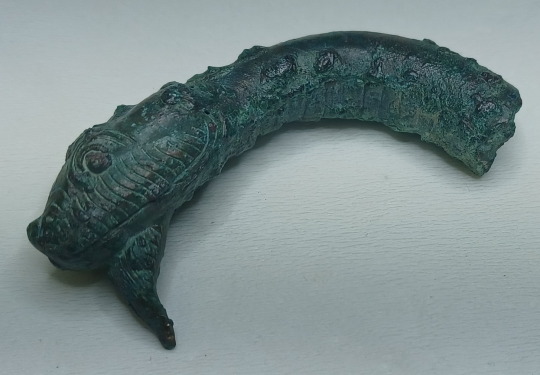
Among their finds, archaeologists identified offerings to the sanctuary’s deity — Poseidon— including clay and bronze figurines, clay chariot wheels, bronze buckles and pins, iron weapons and a rare piece of a golden necklace, according to officials. Evidence of a second deity was also found at the site.
The building remains also revealed that the area was subjected to frequent floods, experts said. This finding indicates that its residents felt a connection to the area because rather than relocating, they continued to build and rebuild the site.

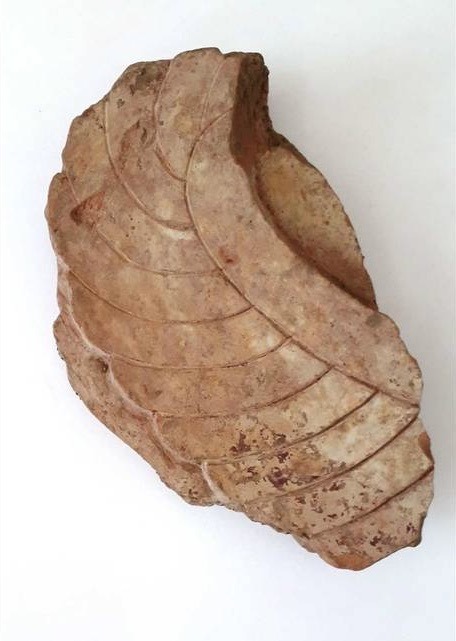
Archaeologists said they also found evidence of animal sacrifices, including goats, sheep and pigs, at the site. There was also indications of grape plant remains, pointing to the importance of wine for rituals at the sanctuary.
Helike was on the southwest shore of the Gulf of Corinth, according to the Helike Project. The Gulf of Corinth is about 66 miles northwest of Athens.
By Moira Ritter.

#2600-Year-Old Artifacts Found at Ancient Greek Cult Center#Helike’s cult center#ancient artifacts#archeology#archeolgst#history#history news#ancient history#ancient culture#ancient civilizations#ancient greece#greek history#greek art
167 notes
·
View notes
Text
Psst-- new sideblog!
So for Barricade Day this year, I started working on a lego barricade, and it kind of got out of control:
There are two posts now, covering LM 4.12.1, "History of Corinthe from its Foundations." The rest of the barricade sequence, starting with "Preliminary Gaieties," will be coming for Barricade Day, assuming nothing interferes with the rest of the photoshoot. (If it does, welp, then it will be coming for next Barricade Day.)
So if that is a thing you would like to see, go subscribe!
9 notes
·
View notes
Text
History of Corinthe From Its Foundation
There was a little wine shop at the end of a cul-de-sac. It used to be called the Pot-Aux-Roses, but then it was called the Corinthe. Now, it no longer exists.
The Corinthe is where Courfeyrac and his friends would often meet. Father Hucheloup, who owned the establishment, was somewhat grouchy and very welcoming. Father Hucheloup died in 1830, and the quality of the food and wine decreased significantly after his passing, but Courfeyrac and his friends still went all the time, perhaps out of pity for Widow Hucheloup.
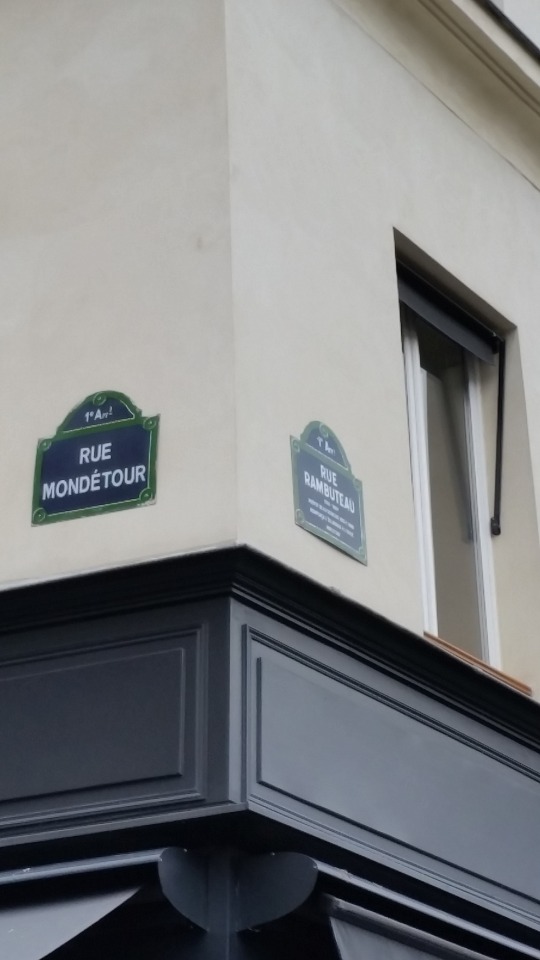

#a year of les mis#volume iv st. denis#book 12 corinthe#chapter 1 history of corinthe from its foundation#4.12.1#277/365#Les Miserables
2 notes
·
View notes
Photo

NAME. Prunelle Lefebvre
AGE & BIRTH DATE. 34 & June 20th, 1987
GENDER & PRONOUNS. Female & She/her
SPECIES. Witch ( Water + Telepathy )
OCCUPATION. Dancer at Ambrosia
FACE CLAIM. Amanda Seyfried
BIOGRAPHY
(TW kidnapping, psychological abuse, violence, murder) This is an Emergency Weather Radio Broadcast. Thunderstorms can be found raging all across parts of Louisiana with some regions expected to get as much as five inches total with some saying they have gusts of wind as strong as thirty mph. Needless to say, plan your next few days of travel accordingly and don’t forget to bring an umbrella.’
June 1987 — Baton Rouge is barely at the start of its hurricane season, the tingle within its air is taut with suffocating humidity and rapid floods. Each day is a mixture between comfortable and too warm, especially for an expecting mother sitting on a hard plastic seat listening to the end of a eulogy. Pearls of thunder rumble the stained-glass windows as individuals in dark mourning attire sit hesitantly around them. Fanning herself lightly, knowing fully that her due date was only days away, a tearful husband sitting next to her and patting the top of her free hand while the other gripped a silk fan. The labor pains had been few and far between. It seemed as though there was nothing to concern themselves with, the baby seeming to be of the more stubborn breed. That is, until she moved to the casket to say her prayers and found her water had broken. A laugh, of all things, escaped her lips instead of worrying cries as those around her moved to her aid. With death comes the beginning of a new life and the following morning, right before dawn, they welcomed their first born. A baby girl with oceanic eyes and a smile that hadn’t even left her in sleep — Prunelle Rosaliné Lefèbvre.
Brought forth by Louisiana socialites, both with a long history tied with France, the young witch enjoyed a life full of plenty and luxury from the moment her sun kissed locks emerged. Wanting for nothing, yet always tinged with this drive for more. Before they knew it, Prunelle was walking and talking fast. She never seemed to have a grasp on where exactly she was going, but she was always in a hurry to get there. Life was fueled by her impulses and it often showed in her energy levels, to the point where her parents were certain she would take after her mother’s lineage. A bloodline that was known for its aversion towards the flame, though time would show the difference between the two and how much she was like her father. Ruled more by her latest wave of emotions rather than the more zealous and logical energy known from the Quinn ménage.
As the years progressed, the family of three quickly grew with the addition of two more young girls. Dubbed by some to be the milk man’s daughter, there was no mistaking her origins once her mouth opened. She led the typical life of anyone under the noble house of Lefèbvre would, at the mercy of the philosophies and practices within the cult of Persephone. Soaking in her parent’s words as if they were gospel, seeing all other avenues as treacherous and placing family above all the rest. Although her fairer features, along with her siblings' chosen element of fire, pushed her towards feeling at moments as if she was an outcast amongst them. There was always a piece of herself that she held close and never felt comfortable sharing with others. Her sisters were there to protect her, to have her back in sticky situations, and keep her from falling too far into her emotions: seeing that vulnerability as more of a weakness. But what intimacy Prunelle couldn’t find in her home life, she found within the structures of her social circles and breed her already turbulent behavior.
Cracks in her foundation and pieces missing, the young witch still attempted to move about life with a rose-tinted outlook. She, like her family, believed wholeheartedly that the goddess herself had given them some kind of edge against all other witches. Hecate may have gifted them with their powers, their chosen craft, but Persephone would grant them a new life. An immortal one that would transform them into the purest form of themselves and only Persephone herself would know when the time was right.
That’s when the murmurs began. So soft and delicate at first, just like the echoes of a stagnant ghost wailing in the midnight fog. Each day the voices grew louder, more lucid and resembling the sounds of those who were near her. Not the goddess speaking to her like she had been so hopeful for, but the private and unshielded minds of anyone within her vicinity. She would make the mistake of answering someone without the words actually leaving their lips, a teen unaware of the manifesting power that she possessed. Stark raving mad, out of one’s head, a few screws loose: Prunelle reluctantly heard it all. Uncomfortable situations after another before slowly learning when and how to tune certain things out. However, much of the damage to her psyche had already been done and it felt like merely placing masking tape on a deep wound. Every praising and malevolent thought from those closest to her had rooted themselves in, no matter how many attempts at scrubbing them away.
Once the witch was on the fringes of adulthood, she took some of her trust fund and headed towards the most sensible location in her mind; Paris. The sounds of the city enthralled Prunelle, looking at the decision as part of her growth, and found kinship through her family's ties to the country of France. Traveling this far from home allowed the distance she desired without being cut off, still influenced by the message that one day— Persephone’s call would grace her. To bide her time, she continued her passion of ballet and enrolled at a local dance studio. Immersing herself as much as possible in what it meant to be a Parisian, along with taking on a more active role within the cult. Her power, even in her youth among her parents' socialite circles, had fascinated them and her emergence in the city hadn’t been ignored. Often sending her on small tasks and gaging how willing the witch was to do as they suggested. It wasn’t until the more serious tasks that the regular compulsion episodes began. Oh, how easy it was to convince her that assisting with a kidnapping or murder was all for the cause. The same ease when exposing her neck by just locking eyes with theirs.
Her years in the European region would continue in much of the same fashion, visiting family back in Baton Rouge when the desire struck, and Prunelle saw no reason to change location until the fall of the veil. The silence she gained when being stripped of her power only planted resentment for being unable to reach her raison d'etre, her purpose. Daphnis’ sacrifice was her gain with its resurgence, though the witch gave the rift no praise and instead thanked Persephone for another chance at her immortal favor. Whispers fluttered in the community that the goddesses' time was near, her shadow being cast upon the city of Corinth, so Prunelle quickly packed her bags and settled in the bayside. Perhaps now, more than ever, the witch can make one’s mark.
PERSONALITY
+ Introspective, pioneering, magnetic.
- Obsessive, forceful, fiercely independent.
PLAYED BY CHARLIE. CST. She/Her.
1 note
·
View note
Text
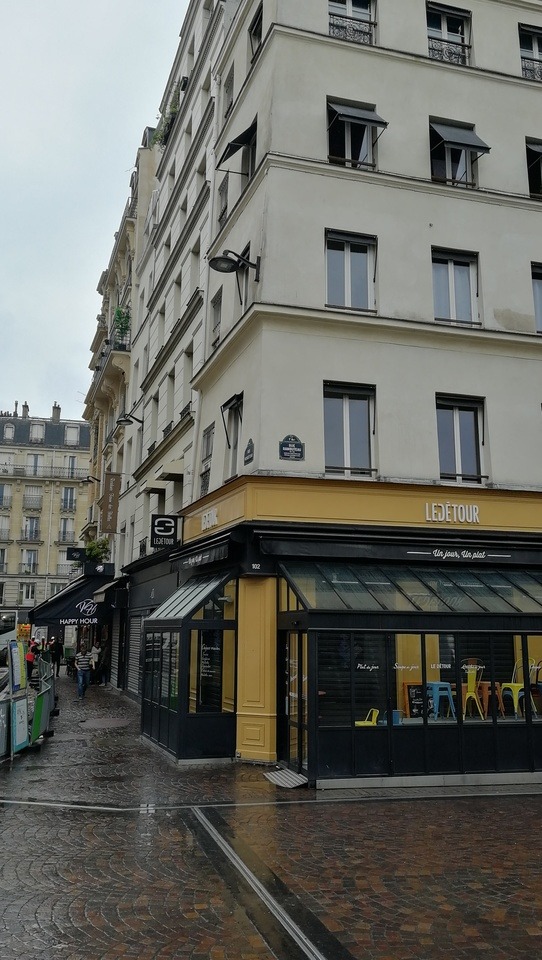
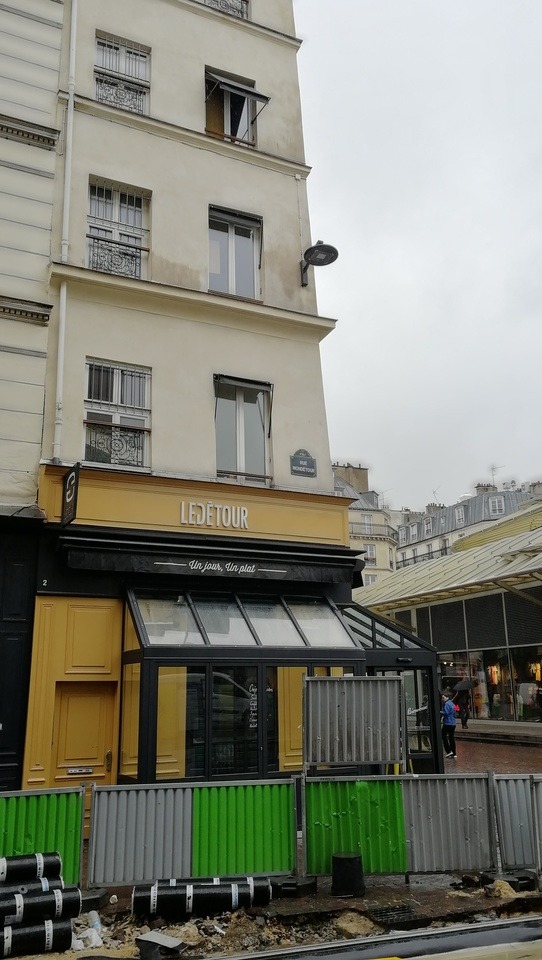
The Corinthe
'The Parisians who nowadays on entering on the Rue Rambuteau at the end near the Halles, notice on their right, opposite the Rue Mondetour, a basket-maker's shop (...) [They] have no suspicion of the terrible scenes which this very spot witnessed hardly thirty years ago.
A room on the ground floor, where the bar was situated, one on the first floor containing a billiard-table, a wooden spiral staircase piercing the ceiling, wine on the tables, smoke on the walls, candles in broad daylight, this was the style of this cabaret.'
- Les Misérables by Victor Hugo, Volume IV - Book Twelfth Corinthe, Chapter I. History of Corinthe from its Foundation
169 notes
·
View notes
Text
BrickClub-4.12.1 The History of Corinth from Its Foundation
Asking me to try and picture streets and buildings is Too Much and I cannot do it. Geography and subsequently Geography Symbolism goes right over my head. Except like, this barricade isn’t even real? But sure let’s shed light on this obscure little place. Okay, Hugo.
We also get a nice Waterloo connection that I’m......unsure about what it all means. But it sure is there.
Sneaky, sneaky describing the interior along with the history almost as if it won’t be important where staircases and billard tables would be. Almost.
We get introduced to Matelote, Gibelotte, and of course, Mame Hucheloup.
Courfeyrac wrote on the door: “Enjoy if you can and eat if you dare.” Which considering the amount of puns that shroud the existence of this place, that doesn’t surprise me.
3 notes
·
View notes
Text
Herodotus and his World
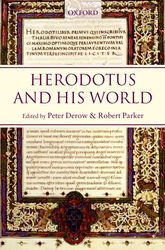
Herodotus and his World: Essays from a Conference in Memory of George Forrest
Peter Derow and Robert Parker
ABSTRACT
This book contains detailed studies of a number of individual passages and episodes (which always turn out to have wider ramifications for the understanding of Herodotus or for the history of the archaic and classical Greek world, or both) as well as considerations of wider themes (perceptions of ethnicity and ideas of ‘tradition’, of historical space and about the origins of history). Topics included are: prophecy, oracle-selling, and resurrection, and also narrative management and the prosaics of death. The Herodotean chronology is revisited. There are also accounts on epiphany, and of why Herodotus did not mention the Hanging Gardens and why he has not been taken as seriously as he should have been by military historians. Finally, the book examines Cleisthenes and Cleomenes, Argos and Corinth, and Athens and its democracy.
Contents
Part I Narrative
1 Authorial Voice and Narrative Management in Herodotus
Roger Brock
2 Pedestrian Fatalities: The Prosaics of Death in Herodotus
Deborah Boedeker
3 Panionios of Chios and Hermotimos of Pedasa (Hdt. 8. 104–6)
Simon Hornblower
4 Herodotean Chronology Revisited
P. J. Rhodes
5 Who Was Actually Buried in the First of the Three Spartan Graves (Hdt. 9. 85. 1)? Textual and Historical Problems
Dwora Gilula
6 The Oldest ‘New’ Military Historians: Herodotos, W. G. Forrest, and the Historiography of War
Eugenia C. Kiesling
Part II Peoples and Places
7 Herodotos (and others) on Pelasgians: Some Perceptions of Ethnicity
Christiane Sourvinou-Inwood
8 Herodotus’ Conception of Historical Space and the Beginnings of Universal History
Josémiguel Alonso-núñez
9 ‘Tradition’ in Herodotus: The Foundation of Cyrene
Irad Malkin
10 Why Did Herodotus not Mention the Hanging Gardens of Babylon?
Stephanie Dalley
11 (Hdt. 6. 108. 1)
Angelos P. Matthaiou
12 Herodotos (8. 137–8), The Manumissions from Leukopetra, and the Topography of the Middle Haliakmon Valley
Miltiades Hatzopoulos
13 Cleisthenes (of Athens) and Corinth
John Salmon
Part III Religion
14 ‘Prophecy in reverse’? Herodotus and the Origins of History
Thomas Harrison
15 Oracles for Sale
Hugh Bowden
16 The Common Oracle of the Milesians and the Argives (Hdt. 6. 19 and 77)
Marcel Piérart
17 Herodotus and the ‘Resurrection’
John Gould
Part IV Herodotus and Athens
18 Herodotos and Athens
Robert Fowler
19 Democracy without Theory
John K. Davies
Herodotus and His World: Essays from a Conference in Memory of George Forrest 1st Edition by Peter Derow (Editor), Robert Parker (Editor) Oxford University Press, 2003
Source: https://oxford.universitypressscholarship.com/view/10.1093/acprof:oso/9780199253746.001.0001/acprof-9780199253746-chapter-10
0 notes
Text
Top 5 places to visit in Greece
Greece is packed with ancient history and known for its plethora of ancient ruins; it is the birthplace of western civilisation, democracy and philosophy, not forgetting the origin of the Olympic Games. It has a significant culture and history like no other country. Today it is a major tourist destination, renowned for whitewashed buildings, sandy beaches, crystal clear waters and tasty cuisine. Here are the top 5 places you must visit in Greece to get the best experience of ancient culture and stunning coastlines.
Acropolis, Athens
If you were told to envision a picture of Athens, the Acropolis will almost definitely be the first thing you will think of. It is the most monumental complex that still exists to this day, and a universal symbol of ancient Greek architecture. It sits on a mountain overlooking the capital city, whilst making visitors feel superior when looking down at the rest of the Athens. It is an accurate reflection of power and wealth of a once Greek Empire. The Acropolis was completed in the 5th Century BC and originally the Temple of Athena Nike. Now it is a major tourist attraction and a UNESCO World Heritage Site, where thousands of visitors climb the famous stone steps and indulge in the classical ambiance, whilst surrounded by spectacular views of a metropolitan city.

Flickr | Tim Zoll
The Acropolis can get very busy all year around so it is best to arrive early, especially in the height of the summer when temperatures can rise to over 30 degrees. What’s more is that there is a brand new Acropolis Museum at the bottom of the mountain, containing archaeological ruins that are too precious to be left at the site. This museum contains the famous Elgin Marbles, which were once home to the Acropolis. Unfortunately, the collection is almost incomplete, with the rest of the Elgin Marbles in the British Museum, causing ongoing controversy with the Greek and British governments. Nevertheless, the Acropolis Museum is perfect for history and archaeological lovers, and the only museum built on top of real archaeological excavations!

Flickr | brownpau
Delphi
If you thought the Acropolis was the only site filled with ancient history, then you haven’t heard of Delphi. It is here in ancient times that was once referred to as the centre of the earth. In fact, this place is the home to Greek mythology, where Apollo was considered an important oracle. In ancient times, people would come to this spot and ask the superior emperors for advice and confess their sins. It is now a UNESCO World Heritage Site, again having remarkable inspiration in the ancient world; left behind are remains of the Temple of Apollo, The Treasury of Athenians and an ancient theatre. Needless to say, if you love a bit of culture and ancient history, it’s the place for you!
It is located in the slopes of Mount Parnassus, approximately two hours from Athens, overlooking the beautiful coastal plain of Corinth. The most famous ruin is the Temple of Apollo, dated back to the 4th Century BC; the column foundations are of porous limestone, a reason for the temple’s fast decaying over the years, with only six columns left to this date. The theatre is by far the most photograph worthy ruin at Delphi, with hundreds of steps leading up to it. This dates back to the 4th Century, being an ancient host to musical contests at the Pythian Games. The views from the theatre are breath-taking vegetated mountains. When standing in the middle of it, it feels so surreal, as though you have travelled back in time!
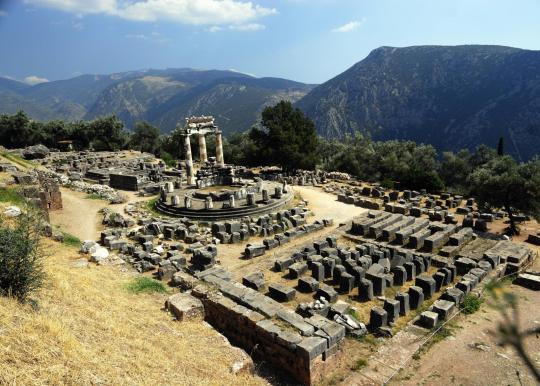
Flickr | Paul Jenkins
Santorini
This one of the most remarkable Greek Islands; the whitewashed buildings with blue roofs, cobble paths and stunning sun sets truly make this island magical! Lonely Planet calls Santorini the ‘supermodel of the Greek Islands’, no surprise due to the amount of A-list celebrities who visit! It’s been visited by Jennifer Aniston, George Clooney and the Kardashians in the past few years, and they have definitely put the island on the map as it is now the most renowned Greek island. Santorini is outstanding when it comes to sunsets, stunning panoramas and volcanic-sand beaches, all of which could in fact be the best in Europe. Believe it or not, Santorini is the remains of a volcanic eruption that destroyed the former settlement, leaving behind a water filled caldera that surrounds the island.

Flickr | Maggie Meng
For those who love to relax on holiday, it’s the place for you! You can lay on the white-sand beaches, indulge in the Mediterranean sun or enjoy the hotel infinity pool looking out into the crystal clear water. For nature lovers, there are many boat trips and cruises which take you to the former crater and hot springs. You can hike the volcano, swim at the red beach and watch the sunset from the greatest place in Europe, the ‘Oia cliffs’. If you are feeling more adventurous, you can take a 30-minute helicopter flight over the stunning island, gazing over the incredible caldera from a birds-eye view, as well as fly over the idyllic whitewashed villages. This is the perfect opportunity to take photographs of the island!
Meteora
If you’re a geography lover, you will adore the nature beauty of this mountainous area. Meteora is a spectacular rock formation in central Greece and one of the largest built complexes sitting on top of natural pillars and boulders that dominate the panorama; it is home to six Orthodox monasteries, built in the 1400’s. As you can see, the pictures of Meteora look very illusory, almost something from an animated film! In fact, this location features in many films such as the 1981 James Bond ‘For Your Eyes Only’, as well as the setting for the Call of Duty: Modern Warfare 3 map. Believe it or not, it was once a place believed to be sculpted by God, for monks who sought immortal life.
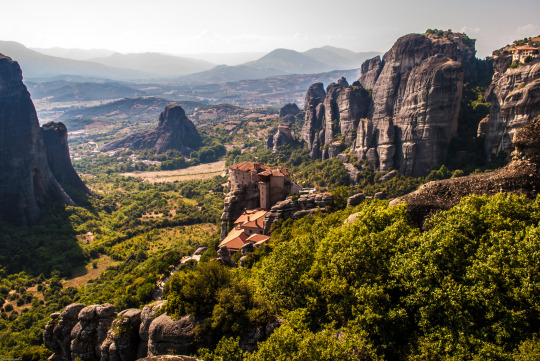
Flickr | Dušan Šteharnik
Today, you can discover the hidden treasures of the area on a hiking adventure! This hike will take you up to the tallest point, 400m above the town of Kalampaka, through ancient winding paths; these are the same paths the monks once walked though on their daily adventures. There are breath-taking views that you will never forget, especially the sunset.
There are a few different tours, including transport from the big cities such as Athens and Thessaloniki so it is easy to arrange. If you love nature, sunsets and rock formations, you can’t miss out on this experience when travelling Greece.
Samaria Gorge, Crete
Not only is this one of the longest gorges in Europe, it is Crete’s only national park and should be the top of the must-dos when travelling to the Greek Islands. The 16km long phenomenon is a must for visitors, especially to complete a 13km walk down the gorge to Agis Roumeli, neighbouring the Libyan Sea; this is where tourists can sail to other nearby villages and embrace the culture of the small fishing towns.
Lucky for us, local tour operators provide organised tours so you are not on your own. The walk takes five to seven hours with amazing waterfalls and picnic areas to stop off at, but it can be strenuous so a somewhat degree of fitness is required, however a shorter route is advised for those who would prefer it, especially in the height of the summer. This attraction really does save the best bit till last, where there is a very narrow passage near the end called the ‘Iron Gates’ with sides closing up to only 4 metres width and a height of almost 300 metres. The most surreal feeling is looking up at this point, and seeing a thin strip of daylight contrasting against the sandstone rocks!

Flickr | Jim Thurston
Greece has so many hidden gems that are somewhat neglected by the popular Greek Island hotel resorts. There is so much more to Greece than the precious white sand beaches that the islands have to offer. As you can see from these 5 places, there is so much ancient culture and natural beauty, which not many people know about. Why not see Greece from a different perspective and visit these mysterious attractions!
64 notes
·
View notes
Text
History of the Corinthe from its Foundations, Part 2
A room on the ground-floor, where the bar was situated, one on the first floor containing a billiard-table, a wooden spiral staircase piercing the ceiling, wine on the tables, smoke on the walls, candles in broad daylight, this was the style of this cabaret. A staircase with a trap-door in the lower room led to the cellar. On the second floor were the lodgings of the Hucheloup family. They were reached by a staircase which was a ladder rather than a staircase, and had for their entrance only a private door in the large room on the first floor.
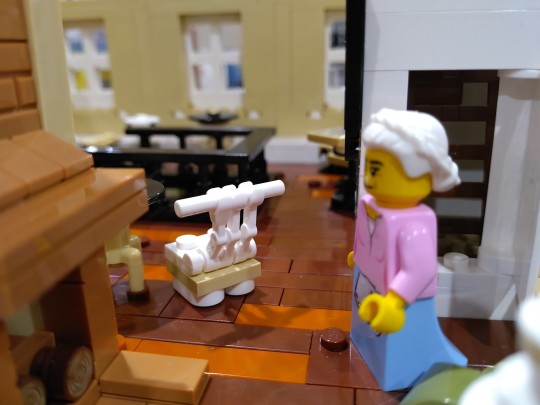
Under the roof, in two mansard attics, were the nests for the servants. The kitchen shared the ground-floor with the tap-room.
Father Hucheloup had, possibly, been born a chemist, but the fact is that he was a cook; people did not confine themselves to drinking alone in his wine-shop, they also ate there. Hucheloup had invented a capital thing which could be eaten nowhere but in his house, stuffed carps, which he called carpes au gras.

These were eaten by the light of a tallow candle or of a lamp of the time of Louis XVI., on tables to which were nailed waxed cloths in lieu of table-cloths. People came thither from a distance.

Hucheloup, one fine morning, had seen fit to notify passers-by of this "specialty"; he had dipped a brush in a pot of black paint, and as he was an orthographer on his own account, as well as a cook after his own fashion, he had improvised on his wall this remarkable inscription:
CARPES HO GRAS.
One winter, the rain-storms and the showers had taken a fancy
to obliterate the S which terminated the first words, and the G which began the third; this is what remained:
CARPE HO RAS.
Time and rain assisting, a humble gastronomical announcement had become a profound piece of advice.

[...] Corinthe was the meeting-place, if not the rallying-point, of Courfeyrac and his friends. It was Grantaire who had discovered Corinthe. He had entered it on account of the Carpe horas, and had returned thither on account of the Carpes au gras.
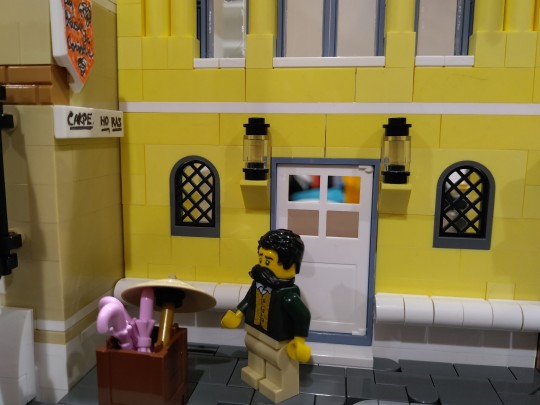
There they drank, there they ate, there they shouted; they did not pay much, they paid badly, they did not pay at all, but they were always welcome.

[...] About 1830, Father Hucheloup died. With him disappeared the secret of stuffed carps. His inconsolable widow continued to keep the wine-shop. But the cooking deteriorated, and became execrable; the wine, which had always been bad, became tearfully bad. Nevertheless, Courfeyrac and his friends con tinued to go to Corinthe--out of pity, as Bossuet said.
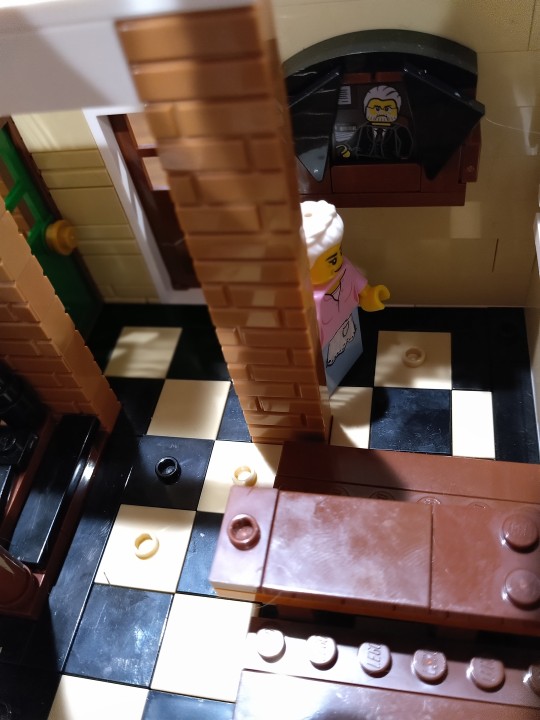
[...] The hall on the first floor, where "the restaurant" was situated, was a large and long apartment encumbered with stools, chairs, benches, and tables, and with a crippled, lame, old billiard-table. It was reached by a spiral staircase which terminated in the corner of the room at a square hole like the hatchway of a ship. This room, lighted by a single narrow window, and by a lamp that was always burning, had the air of a garret. All the four-footed furniture comported itself as though it had but three legs.
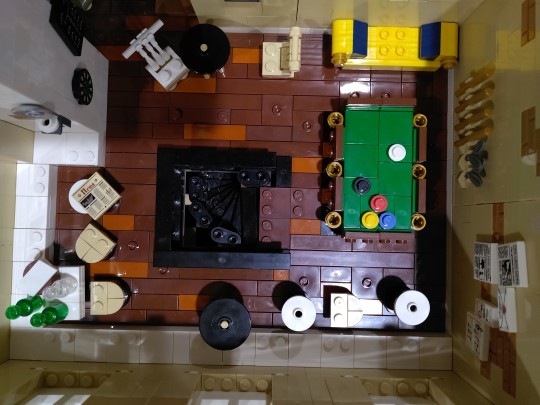
Two serving-maids, named Matelote and Gibelotte, and who had never been known by any other names, helped Mame Hucheloup to set on the tables the jugs of poor wine, and the various broths which were served to the hungry patrons in earthenware bowls. Matelote, large, plump, red-haired, and noisy, the favorite ex-sultana of the defunct Hucheloup, was homelier than any mythological monster, be it what it may; still, as it becomes the servant to always keep in the rear of the mistress, she was less homely than Mame Hucheloup. Gibelotte, tall, delicate, white with a lymphatic pallor, with circles round her eyes, and drooping lids, always languid and weary, afflicted with what may be called chronic lassitude, the first up in the house and the last in bed, waited on every one, even the other maid, silently and gently, smiling through her fatigue with a vague and sleepy smile.

Before entering the restaurant room, the visitor read on the door the following line written there in chalk by Courfeyrac: "Régale si tu peux et mange si tu l'oses.”
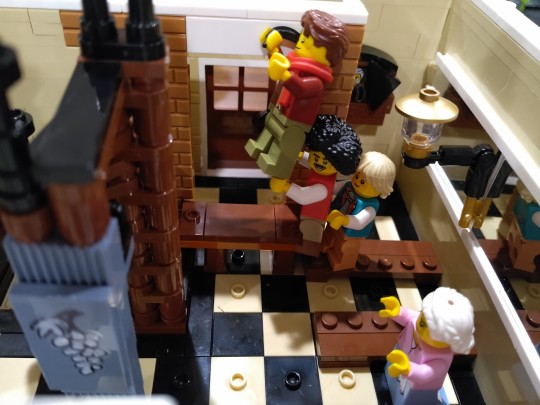
8 notes
·
View notes
Photo
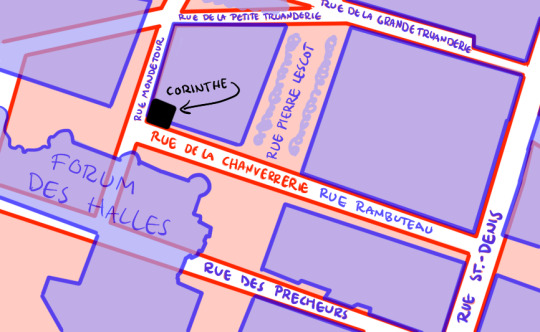

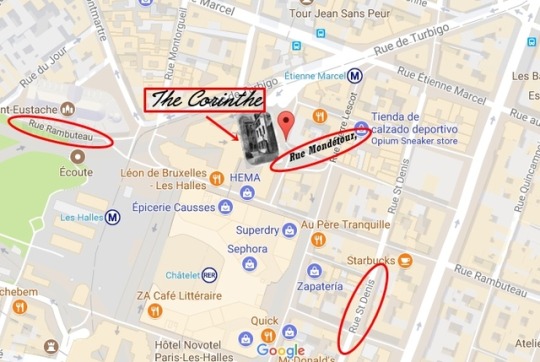
Maps: Paris 1832/Paris today
Persons who wish to picture to themselves in a tolerably exact manner the constitution of the houses which stood at that epoch near the Pointe Saint-Eustache, at the northeast angle of the Halles of Paris, where to-day lies the embouchure of the Rue Rambuteau, have only to imagine an N touching the Rue Saint-Denis with its summit and the Halles with its base, and whose two vertical bars should form the Rue de la Grande-Truanderie, and the Rue de la Chanvrerie, and whose transverse bar should be formed by the Rue de la Petite-Truanderie. The old Rue Mondetour cut the three strokes of the N at the most crooked angles. So that the labyrinthine confusion of these four streets sufficed to form, on a space three fathoms square, between the Halles and the Rue Saint-Denis on the one hand, and between the Rue du Cygne and the Rue des Precheurs on the other, seven islands of houses, oddly cut up, of varying sizes, placed crosswise and hap-hazard, and barely separated, like the blocks of stone in a dock, by narrow crannies.
Chapter I. History of Corinthe from its Foundation
1 note
·
View note
Text
Day 20: Sunday, July 9. Approaching the last station.
The bus ride from Ioannina to Arta is a 44-mile journey south along European route E951 (Greek route EO5), whose southern terminus is the town of Antirrio, on the Strait of Rio between the Gulfs of Patras and Corinth. The road traces the Pindus mountain range, which is home to six of Greece’s eight highest mountains. Along this stretch, however, the mountains are less prominent, but there are more of them - Tomaros is off to the right of the road, Xerovouni is off to the left, and the impressive Athamanika sub-range is just beyond it. They are no Olympus, but Olympus is a point standing alone. Here, the peaks form the sturdy spine of Greece.
Arta (pop. 24,427) was known as Ambracia in the Hellenistic period, during which it served as the capital of Pyrrhus of Epirus’ kingdom. It was incorporated into Rome in the mid-2nd century BC, and became Arta under the Byzantines a millennium later. That legacy is readily apparent in the Church of the Parigoritissa, the Monastery of Saint Theodora, and the castle at the city’s northern tip. The Arachthos, which flows around the city, is spanned by a picturesque four-arch stone bridge in the southwest corner. The current bridge is an Ottoman construction on the site of previous Roman and Byzantine structures. There is a legend associated with it: when it was being built, its foundations would collapse each night. A bird with a human voice informed the chief builder that, in order for the bridge to remain standing, he should sacrifice his wife. As she was being buried alive in the foundations, she cursed the bridge to flutter like a leaf, and those who pass it to fall like leaves as well. But she was then reminded that her brother was currently abroad and might pass the bridge on his return, so she changed her curse into a blessing. Immurement during the construction of buildings is a common motif in Balkan folklore.
A taxi takes A. D. from the Arta bus terminal to Hotel Marathia, about five miles northwest of the city in the village of Chanopoulo. The driver, a lively older man, takes his time getting out of the city in order to tell its history and point out landmarks. After pausing at the bridge, he speeds down a country road that is surrounded by farmland on one side and hills on the other. The hotel is nestled in a grove at the foot of a hill, with plenty of shade and a clear view of the sunset. A. D. is greeted at the entrance by a young woman who checks him in and says that she is the fourth generation of the family that owns the hotel (since 1955). Her father comes down to the lobby and warmly introduces himself before taking A. D. up to his room. With its two beds and a balcony that looks out over the trees, onto the plain and setting sun beyond them, it is entirely too much.
Later in the evening, at dinner, A. D. meets the other volunteers, all from the UK: C. J., T. O., and I. S., a college-aged group of friends; S. M., who is a couple of years older than A. D.; and an older man, J. C. Though she has been staying in an apartment in Filippiada nearby, E. P. stops by briefly to say hello. She is from the Netherlands, and has been with RS in Greece for close to a year. It is good to put a face to the name of A. D.’s primary point of contact since Ioannina/Katsikas.
So it is in Chanopoulo, on the 9th of July.
1 note
·
View note
Photo
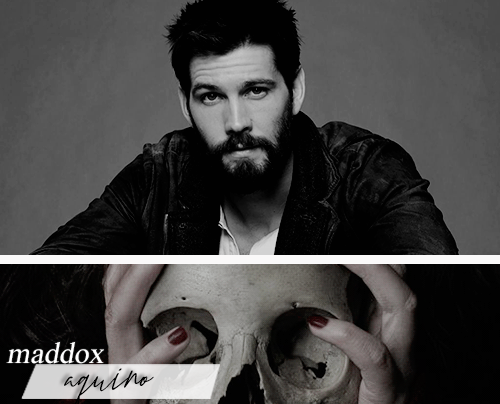
NAME. Maddox Aquino
AGE & BIRTH DATE. Thirty & October 31, 1989
GENDER & PRONOUNS. Male & He/him
SPECIES. Genasi ( water )
OCCUPATION. Medium
FACE CLAIM. Casey Deidrick
BIOGRAPHY
(tw: murder, parental death) Welcomed into the world under the shine of the waxing moon, Maddox Aquino did not utter a noise until days after his birth. Silent like the night, darkened eyes reflected the shine of the growing moon, the one that symbolized purity and enchantment. It was this symbolism that whispered softness, gentleness, fragility upon the newest member of the Aquino family. How his parents fawned over their first born child, basking in the feeling of finally being parents, they took no notice to how very different he appeared from either of them. It was a revelation that would go unnoticed for years to follow, shadowing the newborn into his childhood.
Being born into the lineage of the Aquino witches meant only one thing: a power that came from the water was sure to be in one’s blood. It was the very meaning of the surname, the foundation of what was passed from one generation to the next. It was sure to be in Maddox’s blood just as it was in that of his father’s, and his father’s father before him, so on and so forth for the many generations that came before him. If only his parents hadn’t been so quick to come to this assumption, if only they had been willing to accept the parts of their only child that didn’t quite fit the mold that had been shaped by the lineage of his family.
It all came to light during Maddox’s childhood years, when he was sure to start displaying glimpses of the power that flowed through his blood. His parents watched in quiet anticipation, hoping and praying for the first spark of something at the fingertips of their young son. But it didn’t quite come as was expected. It started with whispers first, spoken into the darkness while Maddox lay curled up in his small bed. They thought it was imaginary friends at first, crafted by a curious and imaginative young mind, brought into existence given that he was an only child. But the whispers only seemed to happen more often, during all hours of his waking day, growing into full conversations and giggles to seemingly thin air. Worry was at the forefront of his parents’ minds, which soon spurred them to seek out guidance from those that had been in the witching community much longer than they had. And what they learned surely turned their blood to ice.
A darkness shrouded the heart of their only child, casting him into the depths of a magic that had long been shunned within the community. It was the knowledge that Maddox sat at the precipice of a dark magic that brought his parents to one quick conclusion: they must keep their son from ever practicing this type of magic. For the better part of his childhood, Maddox was not taught of the magic that lay at his fingertips, that coaxed its way through his veins. He was taught the fundamentals of hydrokinesis, and the ability to manipulate the water around him. It didn’t work, however, sending Maddox into fits of anger at not being able to control what his family had long since been able to. Often times, he found himself in the attic of his family home, milling through old boxes in search of anything to distract himself with.
It was a long forgotten spell book that captivated the young man’s attention, flipping through various pages of spells that had been deemed dark magic many years ago. The book had come from an ancestor, stowed away in the depths of the family’s history, forgotten in its shift from one generation to the next, until it ended up in the hands of the next darkened Aquino. It was with this book that Maddox learned of the true power that nestled in his very bones, that waited patiently at the tips of his fingers until a spell was spoken into existence. It was with this book that he practiced in the hidden depths of the attic, away from the ever listening ears of his parents. He knew they would disapprove, knew that they wanted him to be just as they were. But Maddox had long since come to terms that he wasn’t, that he would never be what they were.
If only he had simply taken it as it were, if only he had stopped pressing for something more, then the inevitable would not have happened. The book had spoke of spirits, of reaching out to those that had long since passed, and the ability to bring spirits back from the other side. The spells were complex, ones that no child of Maddox’s age should have been attempting. He had started off small, garnering a taste for the darkness that his parents had attempted to keep him from. In the depths of the attic, he had drifted from one plane of existence to the next, slipping through the cracks as if it was where he had always belonged. Eventually his need to test his abilities grew, and he pressed on forward through the spells of the book. Until he reached a point that he would not be able to return from, when the need for darkness became too great for him, when that wanting of dark magic became a hunger deep inside of him. The spell seemed simple, a severance from the one deity that kept his true power at bay, a blood ritual that would release his true potential; if only Maddox had been taught the severity of what he was about to do at a much younger age. He had simply not been strong enough, not been experienced enough, and so when the separation of himself from Hecate began, it was his parents who suffered the brunt of his mistake.
Waking to the cold touch of night, Maddox could not recall what had happened hours earlier, was thrown into a state of shock and disbelief at the unmoving bodies of his parents. Despite all that he had learned from the spell book, in his weakened state and with his inexperience, he was unable to reverse what his magic had done. Hours passed him by as he tried, time and time again to drift to the ancestral plane in search of his parents’ spirits to no avail. It wasn’t until the sun peaked over the horizon that Maddox finally stopped trying, that he finally accepted that he was never going to bring his mother or father back from the dead. And it was in his state of shock, in his moment of fear that had him fleeing from his family home, afraid of what would happen if the rest of their coven discovered what he had done.
The fear followed him as he moved from town to town, city to city in an attempt to put as much distance between what he had done and himself as he could. He couldn’t get the images of his parents’ faces out of his head, couldn’t stop imaging what his coven would do if they ever caught up to him. It was by the grace of the spirits that he was still able to communicate, using their guidance to keep him moving forward, manipulating the minds of those that hoped and prayed for an afterlife to keep a roof over his head and food in his stomach. But the longer he stayed in one place, the more the fear crept in at the edges of his mind, forcing him once more onto the road to another city, a new life, and more innocent minds to manipulate into giving him whatever he asked.
It was a fluke that brought him to the city limits of Corinth Bay, Maddox having vowed long ago to go nowhere near heavily populated cities. Namely, those that held larger witch communities. He hadn’t learned enough of their communication when he was younger, and he knew not whether what he had done sparked a big enough need to find him. But something had drawn him to the cobbled streets, something had coaxed him to the city that seemed to thrive on the tales of the supernatural. It was within the city that Maddox would flourish, settling down to create a business off the manipulations of tourists that continued to flock to the streets in search of confirmation that there was something beyond this life of theirs. Even the whispers of the veil didn’t deter the young witch, didn’t send him scurrying for a new city when he was doing so well in this one. After years of being on his own, Maddox had vowed to not become involved in what he could easily flee from if push came to shove. If only he had been taught long ago on what kept the supernatural world from crumbling down around them.
PERSONALITY
+ selfless, meticulous, adaptable
– naive, corruptible, disconcerting
PLAYED BY MAL. PST. She/Her.
1 note
·
View note
Text
19th April >> Pope Francis' Full Address at today's General Audience: On Risen Christ, Our Hope ‘God makes His most beautiful flowers grow amid the most arid stones’
This morning’s General Audience was held at 9:30 in St. Peter’s Square, where the Holy Father Francis met with groups of pilgrims and faithful from Italy and from all over the world. In his address in Italian, the Pope focused his meditation on the theme: “Christ Risen, our hope (cf. 1 Corinthians 15).” After summarizing his catechesis in several languages, the Holy Father expressed special greetings to groups of faithful present. The General Audience ended with the singing of the Pater Noster and the Apostolic Blessing. Below, please find a Zenit working English translation of the Pope Francis' address: The Holy Father’s Catechesis Dear Brothers and Sisters, good morning! We meet today in the light of Easter, which we celebrated and continue to celebrate with the Liturgy. In our itinerary of catechesis on Christian hope, today I wish to speak to you of the Risen Christ, our hope, as Saint Paul presents Him in the First Letter to the Corinthians (cf. chapter 15). The Apostle wishes to settle a problem that surely was at the center of the discussions of the community of Corinth. The Resurrection is the last argument addressed in the letter but, probably, in the order of importance, it is the first: everything in fact rests on this presupposition. Speaking to his Christians, Paul starts from an incontestable event, which is not the success of a reflection of a wise man, but a fact, a simple fact that intervened in the life of some persons. Christianity is born from here. It is not an ideology; it is not a philosophical system, but a journey of faith that begins from an event, witnessed by Jesus’ first disciples. Paul summarizes it thus: Jesus died for our sins, was buried and on the third day He rose and appeared to Peter and to the Twelve (cf. 1 Corinthians 15:3-5). This is a fact: He died, was buried, is risen and appeared, namely, Jesus is alive! This is the heart of the Christian message. Announcing this event, which is the central nucleus of the faith, Paul insists above all on the last element of the paschal mystery, namely, on the fact that Jesus is resurrected. If in fact everything was finished with the death, we would have in Him an example of supreme dedication, but this could not generate our faith. He was a hero. No! He died but is risen because faith is born from the Resurrection. To accept that Christ died and that He died crucified, is not an act of faith; it is a historical fact. Instead, to believe that He is Resurrected, is [an act of faith]. Our faith was born on Easter morning. Paul makes a list of the persons to whom Jesus appeared (cf. cc. 5-7). We have here a little synthesis of all the paschal accounts and of all the people who entered into contact with the Risen One. At the top of the list are Cephas, namely Peter, and the group of the Twelve, then “five hundred brothers” many of whom could again give their testimony, then James is mentioned. The last one of the list – as the least worthy of all – is he, himself. Paul says of himself “as one untimely born” (cf. v. 8). Paul uses this expression because his personal history is dramatic: he was not an altar boy, but a persecutor of the Church, proud of his convictions; he felt himself as a man who had arrived, with a very limpid idea of what life is about with its duties. However, in this perfect picture — everything was perfect in Paul, he knew everything — in this perfect picture of life, one day something happened that was absolutely unpredictable: the encounter with the Risen Jesus, on the road to Damascus. Not only was he a man who fell to the ground there: he was a person gripped by an event, which would have turned upside down the meaning of life. And the persecutor became an Apostle, why? Because I saw Jesus alive! I have seen Jesus Christ risen! This is the foundation of Paul’s faith, as it is of the faith of the other Apostles, of the faith of the Church, of our faith. How lovely it is to think that Christianity is, essentially, this! It is not so much our search in our relations with God – a search, in truth, so vacillating –, but rather God’s search of us in our relations <with Him>. Jesus has seized us, He has gripped us; He has won us, never to leave us again. Christianity is grace, it is surprise, and for this reason it presupposes a heart capable of amazement. A closed heart, a rationalistic heart is incapable of amazement, and cannot understand what Christianity is. Because Christianity is grace, and grace is only perceived and what is more it is found in the astonishment of the encounter. And then, even if we are sinners — all of us are <sinners> –, if our good resolutions remain on paper, or if, looking at our life, we realize we have added many failures . . . On the morning of Easter we can do as those people that Gospel talks about: to go to Jesus’ sepulcher, see the large stone overturned and think that God is bringing about for me, for all of us, an unexpected future. To go to our sepulcher: we all have a little of it inside. To go there, and to see how God is capable of rising from there. There is happiness, joy and life here, where all thought there was sadness, defeat and darkness. God makes his most beautiful flowers grow amid the most arid stones. To be Christians means not to begin from death, but from God’s love for us, who has defeated our severest enemy. God is greater that anything, and only one lit candle is enough to overcome the darkest of nights. Paul cries out, echoing the prophets: “O death, where is thy victory? O death, where is thy sting?” (v. 55). During these days of Easter, let us bear this cry in our heart. And if we were asked the reason for our given smile and our patient sharing, then we can answer that Jesus is still here, that He continues to be alive among us, that Jesus is here, in the Square, with us: alive and risen. [Original text: Italian] [Translation by Virginia M. Forrester] In Italian I greet the Italian-speaking pilgrims. In the atmosphere of the Easter joy, my greeting goes to the young priests of the Diocese of Mantova, accompanied by the Bishop, Monsignor Marco Busca and to you, dear Deacons of the Society of Jesus, gathered here with friends and relatives. I encourage each one to live every day the Gospel of charity. I greet the Sisters of several Institutes taking part in the course promoted by the USMI; the Logudorese Polyphonic Chorale; the Pious Works of the Immaculate Conception with the Friends of Founder Marcucci; and the faithful of Marigliano, who are observing the 80th anniversary of the Crowning of the image of Our Lady of Hope. I hope that this meeting will be for all an occasion of renewed adherence to Jesus and His teachings. Finally, I greet the young people, the sick and the newlyweds. Dear young people, especially you youngsters of the Profession of Faith of the Dioceses of Milan and Cremona, live fully the Easter message, witnessing everywhere peace, gift of the Risen Christ. Dear sick, look at Him constantly who conquered death and who helps us to accept suffering as a privileged moment of redemption and salvation. Dear newlyweds, live your daily family experience in the awareness of the vivifying presence of Jesus in your home. [Original text: Italian] [Translation by Virginia M. Forrester]
1 note
·
View note
Text
Sanctuary Church's Bride Theology: Summary of a Perverted Teaching
Hyung Jin Nim Moon (HJN) is famous for inventing his own interpretations and extensions of Divine Principle and believing and preaching these new versions as the gospel truth. Perhaps the oddest creation of his is the Bride Theology.
The position of the messiah as a bridegroom can be found in both Christian and unification orthodoxy. However, the Sanctuary Church’s particular dogma, which some have labelled the Bridegroom Theology but might more aptly be called the Bride Theology, differs markedly from orthodox teachings of either discipline.
Essentially, the Sanctuary Church (SC) holds as one of its central creeds that all women stand as brides of True Father and, as such, are to understand that this includes a readiness to fulfill the bride’s role of having “intimate sexual relations” (Hyung Jin Nim’s direct terminology) with their bridegroom, True Father. The position as bride and sexual intimacy with the bridegroom is not advanced as an exclusively restorational principle, nor is it,for blessed couples, uniquely tied to ceremonial positions relative to the holy wine ceremony or three-day ceremony. Rather, this teaching applies to all women and at all times. It applies to those in the fallen realm who have not been blessed and undergone the three-day ceremony, but also to blessed wives, second generation women, and even True Father’s own daughters and daughters-in-law.
Hyung Jin NIm further outlines the position of the blessed husband as analogous to the historical role of “best man” in ancient marriage ceremonies. HJN explains that the best man was to stay outside the bridal chamber while the bride and bridegroom “consummate sexual relations.” Then when the “marital sexual relations are done” the best man would announce “behold the bride and bridegroom cometh” and the celebration can begin. HJN states the blessed husband should stand in that position of best man and hold the view: “I will guard you in your intimacy with the bridegroom. I will guard the door and entrance so that you can be intimate with the bridegroom.” He goes on to say “If we had men and husbands that were standing guard like that and encouraging their wife to have that intimacy with Christ … to guard the door and when they come out, to celebrate the intimacy with Christ. If we had husbands like that, think how beautiful that husband would look to that wife.” Note that this is referencing sexual intimacy with the wife of a couple who already have been blessed and gone through the three-day ceremony, not as an act of restoration.
This bride theology teaching extends to the view that the quickest route for humanity’s salvation would have been for True Father to have sex and babies with all the women of the world. As stated by HJN:
“For him to come and take all the women of this world and be their spouse and to have children from every single one of those people. And kill off Satan’s blood lineage. I don’t care if that makes you feel uncomfortable. I don’t care if that makes you feel unnerved. That’s the quickest way to do it.”
HJN holds that one of True Mother’s fundamental failures was that, according to HJN, she resisted this and convinced True Father to not have concubines and sex and babies with other women. According to this teaching, True Mother stood as just one of billions of brides, albeit the “leader of the brides.” HJN subsequently announced his dismissal of True Mother from her position and designated his own wife, Yeon Ah Nim, as “leader of the brides.”
The sexual intimacy component of this teaching is most comprehensively outlined in the April 26, 2015; May 3, 2015; and May 10, 2015 HJN sermons, which were devoted almost exclusively to this teaching. However, important points have also been brought out at other times. For example, in one later sermon, HJN states that True Mother is practicing a type of theological lesbianism because women are supposed to be engaged in “intimate sexual relations” with the messiah, but True Mother has replaced the messiah with herself. In a video testimony, one SC blessed brother reports that he was asked by HJN about what his response would be if he was asked to send his blessed wife to TF’s bedroom for sex.
While not explicitly stated, presumably the Sanctuary Church would assert the same tenet as central to Jesus’ course as well. However, Unification orthodoxy and True Fathers’ basic teaching place emphasis on the importance of Jesus finding a single bride, the True Mother, and completing the Marriage of the Lamb, thus establishing True Parents. This role of the messiah is reflected in such statements of True Father as the following:
"In the history of searching for one man, if you have reached the point of finding that man, then as the next step you must search for a woman. The movement which proposed to search for a woman was the Unification Church we have today…Because Adam and Eve fell and lost their family foundation, another representing perfected Adam meets the perfected Eve and has a family. This is the Feast of the Lamb. …If a perfect man is born, a perfect woman will be born. …The third Adam comes in the position of Adam before the Fall and has to search for Eve before the Fall. The third Adam must find the unfallen Eve and have the Feast of the Lamb” (Blessing and Ideal Family, 1993).
“The bride whom the Christ, who is the bridegroom, is trying to find on this earth is not a woman under the dominion of the fall. He is trying to find a person who is born from an unfallen, pure lineage. The third mother has to be the one who can advance to the position of mother (true mother) as a virgin who has no connection with evil.” (Blessing and Ideal Family, 1993).
However, in Unification orthodox, the failure of Jesus’ mother Mary, Zachariah’s family, and Judas resulted in the failure to have the Marriage of the Lamb during Jesus time. SC teachings would appear to assert another major responsibility of Jesus to have sex and babies with many women.
Note, although the Sanctuary Church often borrows Christian terminology and references the Bible, its teaching on the Brides of Christ differs markedly from Christian orthodoxy and what is found in Biblical passages. Almost universally and throughout Christian history, Christians see Jesus as standing as the bridegroom to the church and thus to all people—women and men. This is based on Biblical verses such as Ephesians 5:22-23, where there is a comparison of the relationship of husband and wife to that of Christ and the Church (“For a husband is the head of his wife as Christ is head of his body, the church”), and Paul’s letter to the Church in Corinth where he referred to the Church in Corinth being espoused to Christ (2 Corinthians 11), and Paul’s letter to the Church in Rome, which he considered as married to Christ.
The SC teachings turns this traditional teaching on its head, stating that Christianity’s view is advocating homosexuality. That is, in Christianity’s claiming that the position “between Christ and his church” is analogous to that of a bride and the bridegroom, this means, according to HJN, “men will believe that Jesus is their lover,” and thus advocate a “homosexual relationship with Christ.”
Initially, based on a review of internet comments, quite a number of SC adherents tried to deny and obfuscate this teaching of the Bride Theology given that, for such a fundamental creed in their teachings, it is not one that is sourced in True Father’s words and is a tenet that would be rejected by most members. Members can accept many things on the basis of restoring the tangled web of history; however, this is not a restorational principle, related to the position of fallen women, but is a fundamental relationship of intimate sexual relations between True Father and all women, including blessed wives and second and third generation. Despite the initial resistance of SC members to acknowledge this, over time, as the talks by HJN continued on this theme in various presentations over a number of months, and with specific mention of this involving intimate sexual relations, and with HJN”s encouragement of women to be proud of their role as brides—such as being proud about sexual dreams with True Father—many SC members began to talk about this teaching as the original substance of the Divine Principle, as a principle that True Father’s wished to teach but never got the opportunity to teach. Of course, in their approaches to non-SC members, many in the Sanctuary Church continue to try to frame the discussion in nuanced terms to obfuscate this central and startling teaching,so clearly expressed by HJN in his earlier sermons.
It should be noted that this teaching offers several theological problems, beyond that fact that one would think such a central teaching would be openly addressed by True Father, and the fact that the Biblical references to Christ as the bridegroom offer a very different perspective.
As already noted, one fundamental problem of the Bride Theology is that it includes blessed wives and second and third generation women. That is, the intimate sexual relations with True Father do not serve a particular restorational role, but represent an eternal principle, an eternal relationship, that applies to blessed wives—who have gone through the holy wine and three-day ceremonies and have a husband—and to second and third generation, who are born cut from original sin. Moreover, it includes True Father’s own daughters and daughters-in-law, for whom it would go against any cultural norms to believe they should be open to having intimate sexual relations with True Father, whether on Earth or in the spiritual world.
Overall, the Bride Theology involves a principle where women have sexual relations with someone who is not their intended spouse, and for blessed wives to have intimate sexual relations with two men, one their true bridegroom (True Father) and one their blessed husband. It leads to the accusation of one women having two husbands, and one man having multiple wives. (Some SC avoid this theological issue by saying True Father is God Himself and thus one cannot say having two men in the position of husband, for one is God.)
This also leads to a problem of future men standing in the central leadership position having carte blanche to manipulate things inappropriately; for example, since the SC claims that one of True Mother’s fundamental providential failures was not welcoming TF having sexual relations with other women throughout her life, then one in a leadership position can claim this needs to be restored by the leader having multiple sexual relations with the support of the wife (leader of the brides).
Most fundamentally, while this creed is seen as of major importance in the SC and has been addressed publicly by HJN in many talks, it was not addressed publicly even once by Rev. Moon.
1 note
·
View note
Quote
Interpretations go awry when they ignore or misunderstand New Testament statements about “the last days.” This includes not only end-time prophecy but other topics as well; for example, the gift of the Spirit and its significance in the redemptive plan of God.
When we hear “last days” we assume it is a reference to a final short period just before Jesus returns. But the New Testament presents the “last days” as an era of fulfillment that began with the death, resurrection and the exaltation of Jesus.
The book of Hebrews begins with a declaration concerning how God “in these last days spoke to us by a Son.” Hebrews 9:26 describes how Jesus “appeared once for all at the end of the age to put away sin by the sacrifice of himself.” Such passages place Jesus at the start of this period or, more correctly, as its starting point.
(Hebrews 1:1-3) – “Whereas, in many parts and in many ways of old, God spake unto the fathers in the prophets, At the end of these days, He hath spoken unto us in his Son,—whom he hath appointed heir of all things, through whom also he hath made the ages; Who, being an eradiated brightness of his glory, and an exact representation of his very being, also bearing up all things by the utterance of his power, purification of sins having achieved, sat down on the right hand of the majesty in high places.”
The book of Hebrews begins with a declaration concerning how God “in these last days spoke to us by a Son.” Hebrews 9:26 describes how Jesus “appeared once for all at the end of the age to put away sin by the sacrifice of himself.” Such passages place Jesus at the start of this period or, more correctly, as its starting point.
The Apostle Paul wrote to the Corinthians, “the appointed time has been shortened…For the forms of this world are in the process of passing away” (1 Corinthians 7:29). The last verb is in the Greek present tense, which signifies continuing action; the forms and institutions of this age have been passing away ever since the death and resurrection of Jesus.
A few passages later, Paul described how the Hebrew scriptures were written down for the instruction of Christians at Corinth, the ones “upon whom the end of the ages has come” (1 Corinthians 10:11). The Apostle made a similar point to the Galatians when he declared that “when the fullness of time had come, God sent forth his Son” (Galatians 4:4).
Peter, in his sermon on the Day of Pentecost, changed the opening word of Joel 2:28 from “afterward” to “in the last days, God declares, I will pour out my Spirit upon all flesh…” (Acts 2:17). He linked the outpouring of the Spirit to the last days; the gift of the Spirit demonstrated that the era predicted by Joel had begun. Similarly, Peter declared that Jesus was destined “before the foundation of the world but was made manifest at the end of the times for your sake” (1 Peter 1:20).
John in his first epistle warned his congregations that “it is the last hour; and as you have heard that antichrist is coming, so now many antichrists have come; therefore we know that it is the last hour” (1 John 2:18).
Such references about the “last days” have caused confusion for some and provided fodder for critics. For example, some voices argue that the first Christians, including Jesus, believed the second coming would occur in their day. They, obviously, were quite mistaken. But this misunderstands the Bible’s concept of the “last days.”
The Hebrew scriptures see history divided into two ages; the present evil age and the “age to come,” the latter a term found several times in the New Testament. The coming age would be ushered in when the Messiah came. Beliefs about the details may have varied within Israelite society but the basic outline remained the same.
By the first century AD, some Jewish leaders were looking for a royal and militaristic messiah who would destroy the nation’s enemies and free Israel from foreign domination. Others waited for a priestly messiah.
Two scriptural promises became key to messianic expectations: the expected outpouring of God’s Spirit and the resurrection of the dead (Joel 2:28, Ezek. 37:26-27). Such expectations were in mind when faithful Israelites spoke of the “last days.”
These expectations came to fruition in the life, death, and resurrection of Jesus, only not in the ways expected by his Jewish contemporaries. In his ministry, Jesus inaugurated the "kingdom of God"; no term is found more often on his lips in the gospel accounts. In his exorcisms and healings, Jesus was reclaiming “territory” for God and “binding the Strong Man,” Satan. Such miracles demonstrated the arrival of God’s kingdom and the activity of His Spirit. The "last days" had arrived.
The task of gospel proclamation that Jesus assigned to his church is to herald the arrival of God’s kingdom and to call all who will heed to act accordingly. In Jesus, God has inaugurated His reign on the earth and it will continue to move forward to its final consummation when Jesus returns.
The resurrection of Jesus marked the start of the general resurrection expected in the last days. This is why the New Testament calls his resurrection the “firstfruits” of our own (1 Corinthians 15:20). The gift of the Spirit is also the “firstfruits” of the future redemption of our bodies (Romans 8:23). The Spirit is linked with bodily resurrection because resurrection is an act of new creation. From the beginning, God’s Spirit has been the agent of creation and the source of all life (Genesis 1:1-2).
The gift of the Spirit is our “earnest” (arrabōn), God’s “down payment” on the future bodily resurrection and the New Creation, His rock-solid “guarantee” that He will complete what He started in the resurrection of Jesus Christ (2 Corinthians 1:22, 5:5, Ephesians 1:13-14).
The “last days” have been underway since the resurrection of Jesus and the outpouring of the Spirit. The Cross was far more than the execution of Jesus or a model for selfless living. On it, God defeated all the “powers and principalities” that were opposed to Him and had enslaved mankind. The final victory has already been won and it is cosmic in scope.
With Calvary, history has entered its final phase. The existing order has been winding down to its final destruction ever since; it is in its final death throes. Jesus through his church is engaged in a “mopping up operation,” especially as his people proclaim the good news of God’s kingdom to all the nations.
The “last days” is NOT a chronological marker but a theological concept; it refers to the state of affairs that has been in existence since the death and resurrection of Jesus.
Salvation is now available to all who willingly receive it. God is establishing His final rule over the earth. He has constituted his people, Jew and Gentile, a “kingdom of priests” to mediate His presence and light to a darkened world. The church is God’s people and now lives “between the times.” She belongs to the coming age but still lives in the old one in unredeemed bodies.
In Jesus, and subsequently, in his church, the future age has irrupted into the middle of the old order. The early church did not have an otherworldly outlook but a future-oriented one. It looked for salvation in the coming age.
Jesus will usher in the final consummation when he arrives in glory to resurrect the dead and bring in the New Creation. The final result will not be the destruction of the material universe but a New Heaven and Earth.
http://finishedword.blogspot.com/2019/07/the-last-days-in-hebrews.html
#SEO#Local SEO training The Last Days in Hebrews http://finishedword.blogspot.com/2019/07/the-last-d
0 notes